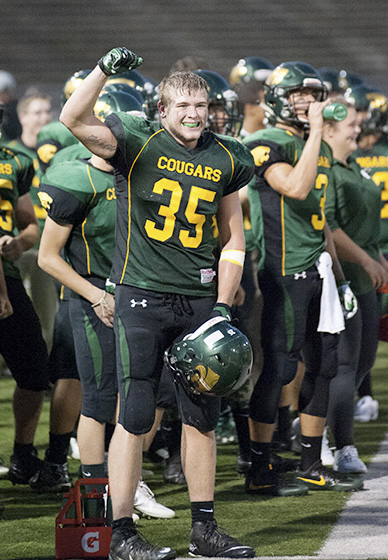Creating a pipeline of team leaders
Just as you must analyze, recruit, develop and replace your team’s physical talent, you must also do the same with your team leaders.
Most coaches are familiar with depth charts. These help you stay on top of your team by visually seeing your personnel strengths, weaknesses and liabilities. If there is a hole in any position, you must proactively plan to shore it up should an injury or other problem occur.

Similarly in recruiting and drafting at the professional level, coaches must project ahead in the coming years to fill certain positions that will be lost to graduation or retirement. Complicating matters further, some college coaches must conjecture whether their athletes might be turning pro or taking off a season to play with the national team.
Thus, a detailed depth chart is a necessity for both short- and long-term planning. While most coaches create and monitor a meticulous positional depth chart for the physical skills and talent, they often overlook a critical area to their team’s success — leadership.
Many coaches subscribe to what I call the “magic eight ball theory” of leadership development. This means they enter each season hoping that good leaders will appear by chance. Unfortunately, it’s often too late at this point.
This is where a “leadership depth chart” can be a big help. Like a positional depth chart, you must analyze your team’s leaders for the upcoming years. You must evaluate their leadership ability as well as their readiness to assume a leadership position.
Here are 10 steps to create your own leadership depth chart based on the ones we use with our leadership academies.
1. Preparation.
Start by making six columns on a spreadsheet or a piece of paper. This is how you’ll plan for the future of your program.
2. ‘Season.’
In the first column titled “season,” write in the years of your next four upcoming seasons. This will help you to create a long-term plan.
3. ‘Leaders.’
Write “leaders” in the second column. Here you should put in the names of people who you think will be your primary and secondary leaders for each particular year. These should include those who you think will be your team captains. Also, include the names of potential core team leaders, even though you might not officially make them captains.
When doing this, I encourage you to think about the leadership skills of your best athletes, especially your most talented younger athletes. Typically, your best athletes already have a good amount of respect from their teammates based on talent. The other players often look to them for leadership because of their “status” on the team. Take advantage of the platform of respect they already have and be sure to invest some time in their leadership skills while they are young.
4. ‘Readiness.’
 Title the third column “Readiness.” Using a one to 10 scale, rate each of your anticipated leaders. A 10 means they are fully ready and have the leadership skills necessary to step in on day one. These leaders understand your philosophy, work hard every day, make great decisions away from the playing field, have developed effective relationships with teammates, and are willing to confront and hold people accountable.
Title the third column “Readiness.” Using a one to 10 scale, rate each of your anticipated leaders. A 10 means they are fully ready and have the leadership skills necessary to step in on day one. These leaders understand your philosophy, work hard every day, make great decisions away from the playing field, have developed effective relationships with teammates, and are willing to confront and hold people accountable.
Obviously, not many athletes rated “one” will make your depth chart. Most of your ratings will likely be in the four to eight range. This means most need more leadership development and coaching in order to be better prepared when you eventually rely on them during upcoming seasons.
Like you did previously, be sure to rate the leadership readiness of your younger, more talented athletes. If they are deficient in the leadership area, you must make the decision of whether you are going to invest the time to improve their leadership skills to bring them up to speed. You might also try to rely on less talented players who have a strong foundation for leadership. By projecting ahead three to four years, you should be able to do both.
5. ‘Strengths.’
This will be your fourth column. List the current strengths of each prospective leader and what they bring to the team. You want to build on these strengths in the coming seasons and make sure the leader recognizes what he or she does well.
6. ‘Weaknesses.’
This is the title of your fifth column. Note the current weaknesses and areas of improvement for each of your leaders. What specific skills or insights do they need to gain to be a better leader for your team? Highlight their areas needing development.
You might also notice in this section that many of your potential leaders probably share similar deficiencies, typically in the areas of conflict management and enforcing the standards of your team. These common areas of development will help you with the last column.
7. ‘Development Plan.’
This will be your sixth column. Based on the leader’s strengths and weaknesses, devise a customized development plan that helps them improve as a leader. You can assign them readings, have them shadow and interview a leader who excels in an area where they are weak, role play how to handle some challenging situations they will face, or get them some 360-degree feedback on their leadership from teammates and coaches.
Like you do when trying to develop an athlete physically, create some learning experiences that help them grow as a leader.
8. Staff depth charts.
Encourage your assistants to sketch out their own leadership depth charts. Then invest the time to discuss your findings and projections as a group. While you will likely agree on most prospective leaders, there will be times when a dark horse candidate is worth betting on. Also, your readiness ratings of leaders will likely be somewhat different. Whatever the case, proactively analyzing and discussing your leadership depth eventually pays off immeasurably and is worth the short time and effort.
9. Talk to the leaders.
Personally and privately inform your “high potential” leaders that they have a chance to be a future team leader. Let them know that you appreciate how they carry themselves and that you think they have the chance to be a future team leaders.
Hearing from a coach that they are respected and have potential is a huge boost of confidence for most athletes. Many rise to the occasion and do their best to prove you right. They will do their best to live up to the positive impression you have of them. You might need to remind them that your respect and that of their teammates is something that they must continually earn and maintain through their actions. Tell them that you would like to invest time with them to further develop their leadership skills.
10. Invest in the leadership.
After creating a leadership development plan, follow up and invest the time develop your young leaders. There are a variety of ways you can do it including the following used by some of your coaching colleagues.
During the offseason, some coaches invite a group of sophomores in on a regular basis to discuss their leadership philosophy and how their team can better develop as leaders.
The primary point is that if you want to have strong veteran leaders, you must proactively invest the time to develop athletes when they are younger to create a reliable pipeline. As I’ve said before, “If you want your leaders to be an extension of you, you must extend yourself to them.”
For more info on helping your team win championships, visit www.JanssenSportsLeadership.com.





